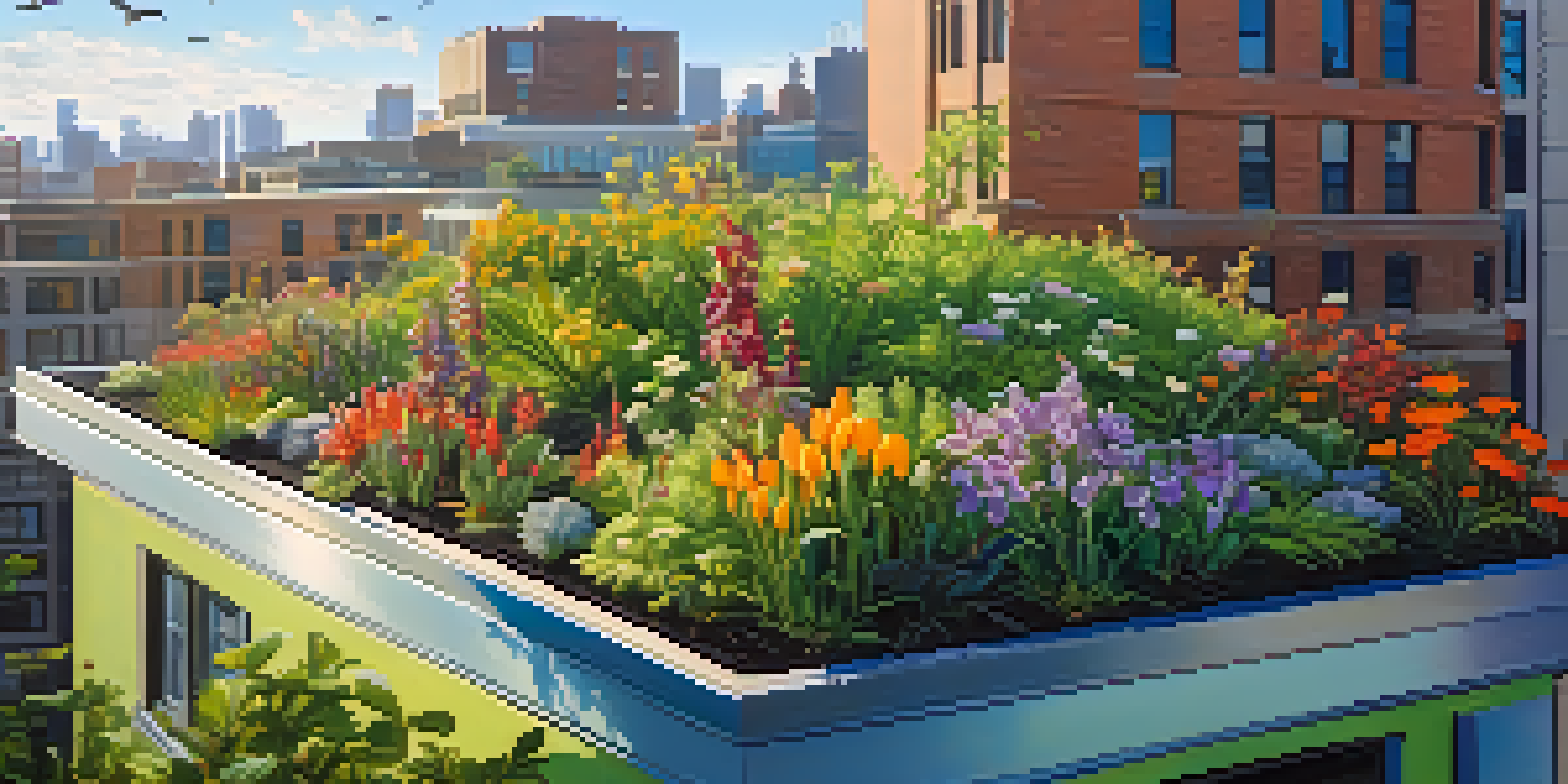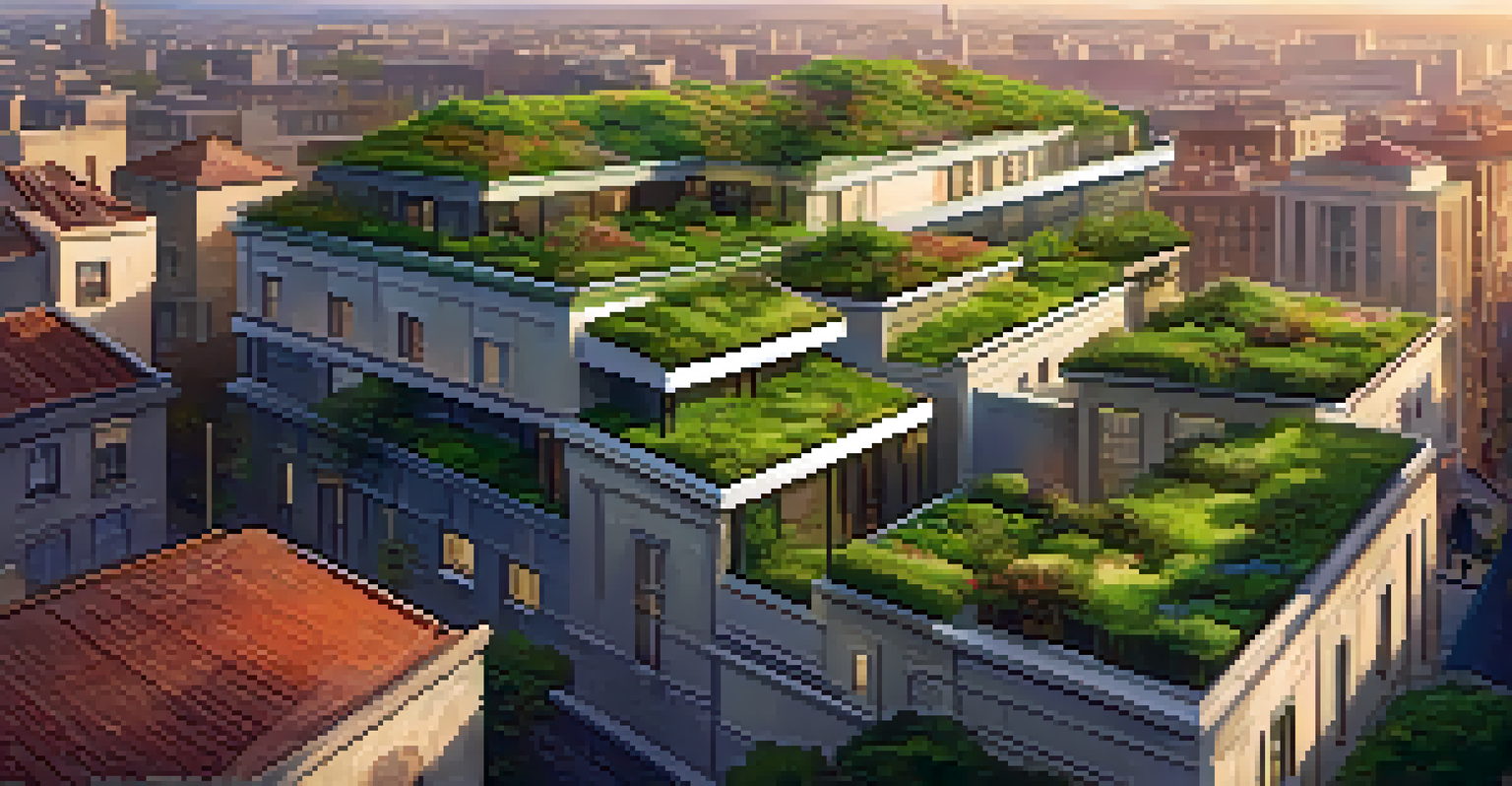Green Roofs and Their Contribution to Urban Air Quality

What Are Green Roofs and How Do They Work?
Green roofs, often referred to as living roofs, are layers of vegetation installed on rooftops. They consist of a waterproof membrane, a drainage layer, and a growing medium that supports plant life. By integrating greenery into urban environments, these roofs create a more sustainable and aesthetically pleasing atmosphere.
Green roofs are a simple way to create healthier, more sustainable urban environments.
One of the primary functions of green roofs is to absorb rainwater, which reduces runoff and helps manage stormwater. This not only prevents flooding but also filters pollutants from the water, improving overall urban water quality. Additionally, they provide insulation, which can reduce energy costs for buildings.
In essence, green roofs act as miniature ecosystems that contribute positively to the urban landscape. They provide habitat for various species, promote biodiversity, and ultimately create a healthier living environment for city dwellers.
The Link Between Green Roofs and Air Quality
Air quality in urban areas often suffers due to pollution from vehicles, industrial activities, and construction. Green roofs play a vital role in mitigating these issues by absorbing carbon dioxide and releasing oxygen through photosynthesis. This natural process helps to purify the air we breathe.

Moreover, the vegetation on green roofs can capture particulate matter, which is a significant contributor to air pollution. By trapping dust, smoke, and other airborne particles, these roofs help reduce the concentration of harmful substances in the atmosphere. This can lead to healthier air for urban residents.
Green Roofs Enhance Urban Sustainability
Green roofs absorb rainwater, improve air quality, and promote biodiversity, making urban environments more livable.
As cities grow and expand, prioritizing air quality becomes increasingly important. Green roofs are a sustainable solution that not only enhances the beauty of our urban spaces but also actively works to improve the air we share.
How Green Roofs Reduce Urban Heat Islands
Urban areas often experience higher temperatures than surrounding rural areas, a phenomenon known as the urban heat island effect. This is primarily due to the abundance of concrete and asphalt, which absorb and retain heat. Green roofs help combat this effect by providing a natural cooling mechanism through the process of evapotranspiration.
In nature, nothing exists alone.
When the plants on green roofs release moisture into the air, it creates a cooling effect that can lower surrounding temperatures. This not only makes the urban environment more comfortable for residents but also reduces the demand for air conditioning, leading to lower energy consumption.
By reducing the urban heat island effect, green roofs contribute to improved air quality. Cooler temperatures can lead to decreased ozone levels, which is a significant pollutant that can harm human health. Thus, integrating green roofs into city planning is a win-win solution for climate and air quality.
Biodiversity Benefits of Green Roofs
One of the lesser-known benefits of green roofs is their ability to foster biodiversity in urban settings. These living roofs serve as habitats for various species, including birds, insects, and even small mammals. By creating green spaces in densely populated areas, they offer crucial ecosystems for wildlife.
The diverse plant selection on green roofs can attract pollinators like bees and butterflies, which are essential for maintaining healthy ecosystems. This not only enhances the local biodiversity but also supports agricultural practices by promoting pollination.
Economic Benefits of Green Roofs
While initial costs may be higher, green roofs lead to long-term savings on energy and increase property values.
Furthermore, increasing biodiversity contributes to a more resilient urban environment. Healthy ecosystems are better equipped to withstand challenges such as disease outbreaks and climate change, ultimately benefiting urban air quality and overall livability.
Economic Advantages of Implementing Green Roofs
While the initial investment for green roofs may be higher than traditional roofing systems, the long-term economic benefits are substantial. By improving air quality and reducing energy costs, green roofs can lead to significant savings for building owners and tenants. Lower energy consumption translates to decreased utility bills, making green roofs a financially savvy choice.
Additionally, properties with green roofs often see an increase in market value. As cities prioritize sustainability, buildings that incorporate eco-friendly features attract environmentally conscious buyers or renters. This increased demand can enhance property values and provide a competitive edge in the real estate market.
Moreover, green roofs can contribute to job creation in the landscaping and construction industries. As the trend of green building continues to grow, the demand for skilled workers in these sectors will also rise, providing a boost to local economies.
Challenges and Considerations for Green Roofs
Despite their numerous advantages, implementing green roofs does come with challenges. One major consideration is the structural integrity of the building. Not all buildings are designed to support the additional weight of a green roof, so a thorough assessment is necessary before installation.
Another challenge is the selection of appropriate plant species that can thrive in the specific urban environment. Factors such as climate, sunlight, and maintenance needs must be taken into account to ensure the longevity and health of the green roof. Proper planning and design are crucial for successful implementation.
Challenges in Green Roof Implementation
Successful green roof installation requires careful planning, structural assessments, and ongoing maintenance.
Finally, ongoing maintenance is essential to keep green roofs functioning optimally. This includes regular inspections, irrigation, and plant care. While the initial setup may require effort and investment, the long-term benefits for urban air quality and overall sustainability are well worth it.
The Future of Green Roofs in Urban Planning
As cities continue to grow and face environmental challenges, the future of green roofs looks promising. Many urban planners and architects are recognizing the importance of integrating nature into city designs. This shift towards sustainable architecture is paving the way for more green roofs in urban landscapes.
Moreover, governments are increasingly offering incentives and grants to encourage the adoption of green roofs. These initiatives not only support environmental goals but also promote public awareness about the benefits of green spaces in urban areas.

Ultimately, the rise of green roofs signifies a collective movement towards healthier, more sustainable cities. By prioritizing green infrastructure, we can significantly improve urban air quality and create more livable spaces for generations to come.